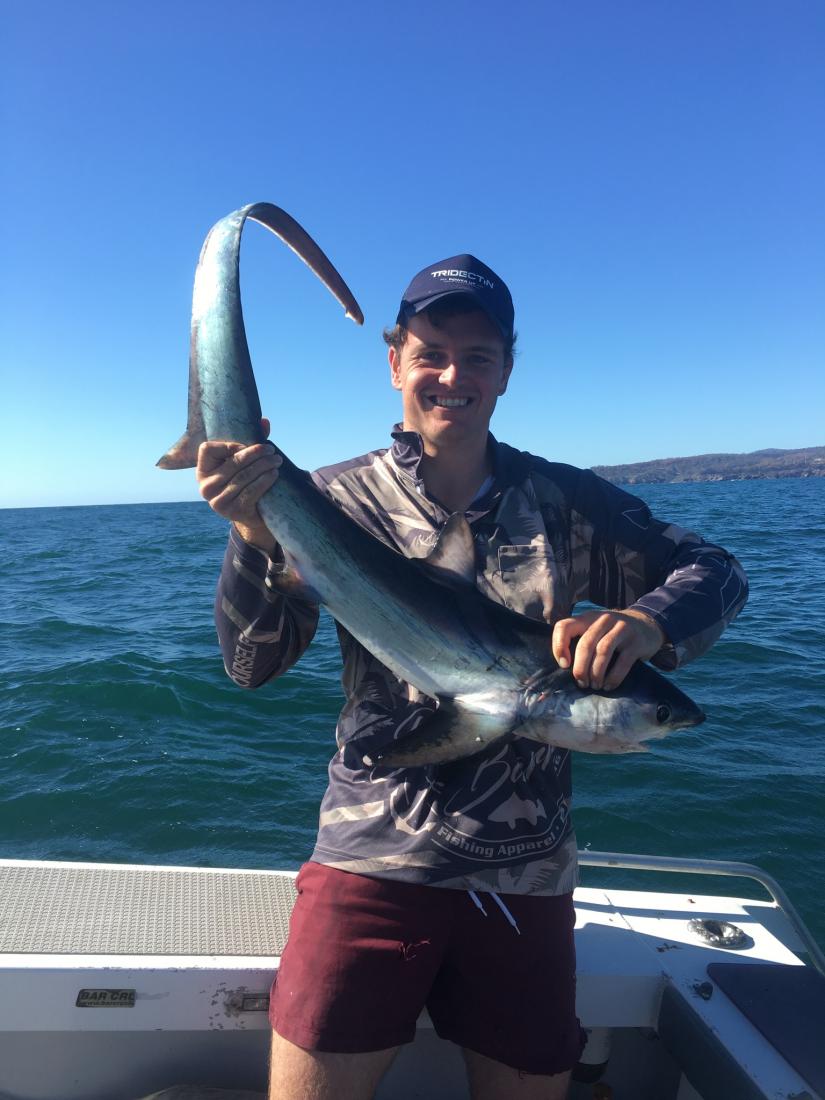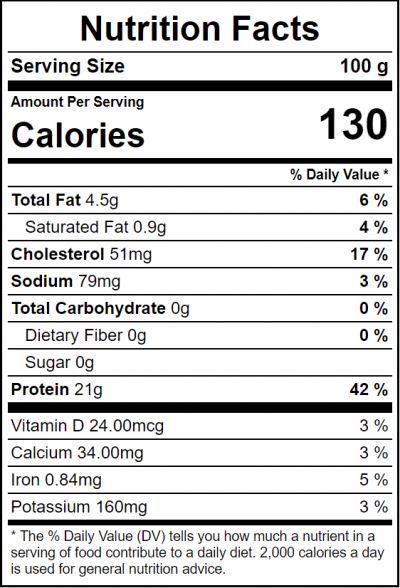Pacific Common Thresher Shark
Alopias vulpinus
The Science
THE SCIENCE
The Pacific common thresher shark is a combative hunter that uses its tail to stun its prey, like mackerel.

Taxonomic description
- Easily recognized by a long sickle-shaped tail fin that measures up to half the span of its body. Other fins are usually a darker color and may have white dots on the tips. [1]
- Has a white underside, lighter-colored sides, and a variety of other colors on its back and under the snout. [1]
- At around 5 years old it can grow up to 5 feet in length and grow to about 18 feet on average at full maturation. [5]
Distribution
- Found in warm, temperate waters throughout the Indian, Atlantic, Mediterranean, and Pacific oceans. [2]
- Off the western coast of southern California to Baja California, adults generally follow temperate waters. Adults are noted near Mexico in January, migrate north toward Washington in late summer, then drift south toward southern California by fall. [2,5]
Life history
- Can live up to 50 years. [1]
- Males are sexually mature at about 6 years old and 8-11 ft long, and females are mature at about 5 years old and up to 9 ft long. [1]
- Eggs are fertilized around midsummer and develop inside females for about 9 months. Then females give birth to 2-4 live pups around spring. [5]
Habitat
- Adults remain offshore at no more than 200 miles from the coast while pups can be found in shallow, coastal regions. [3]
- Prey includes anchovy, herring, Pacifc sardine, mackerel, Pacific hake, lancetfish, squids, octopus, shrimp, pelagic red crab, lanternfish, and Pacific salmon. [2]
- Predators of thresher shark include larger sharks and killer whales. [3]
The Fishery
THE FISHERY
Thresher sharks are usually caught by mouth-hooking and drift gillnets.

Seasonal availability
- Fishing is year-round but restricted when quota is reached. [1]
- As it is widely distributed it is often caught as bycatch in fisheries worldwide. [1]
Regulatory and managing authority
- Internationally overseen by the Inter-American Tropical Tuna Commission (IATTC) and the Western and Central Pacific Fisheries Commission (WCPFC). [5]
- Along the Pacific West Coast, the fishery is overseen by NOAA fisheries and, as established by the Magnuson-Stevens Act, the Pacific Fishery Management Council through the West Coast Highly Migratory Species Fisheries Management Plan. [5]
- As established by the Marine Life Management Act, the California Department of Fish and Wildlife (CDFW) collects data on the thresher shark fishery through the Pelagic Fisheries and Ecosystems Program. [9,10]
Gear type
- Circle hooks are recommended for anglers as it is less dangerous and not as prone to accidental catch. [4]
- Various mouth-hooking techniques used. [4]
- Drift gillnets are used. [5]
Status of the fishery
- Not overfished and not at risk of overfishing as of 2018. [5]
Potential ecosystem impacts
-
Habitat not at risk because the drift gillnets used to harvest are used in the water column such that they do not disturb the ocean floor. [1]
-
Bycatch from drift gillnets are a concern, as protected marine mammals and other species may be caught as bycatch. [5]
The Seafood
THE SEAFOOD
Thresher sharks were replaced by swordfish as drift gillnet fisheries' primary target species, as prices for swordfish increased.


Edible portions
- The meat is typically preferred over fins. [7]
Description of meat
- Thresher shark has a mild flavor, and is firm and dense with a meaty texture. [1]
- It is white or light-colored with pink blood line when raw. [1]
Culinary uses
- Thresher shark can be broiled or grilled. [7]
- For a grilled thresher shark recipe, visit The Stay Home Chef. [11]
- For a fried shark recipe for Trinidad Bake and Shark, visit CaribbeanPot.com. [12]
Nutritional information
- Nutrition facts table for raw thresher shark (right). [5,6]
Toxicity report
- Although it is exposed to domoic acid (DA) through its diet of sardines, mackerel, anchovies, and squid, it does not seem to have levels that are toxic to humans. [8]
Seasonal availability
- Year-round. [5]
References
[1] NOAA Fisheries. “Pacific Common Thresher Shark.” Web. https://www.fisheries.noaa.gov/species/pacific-common-thresher-shark. Accessed 25 Feb 2020
[2] Lewis, J. 2011. Alopias vulpinus. Animal Diversity Web. Web. https://animaldiversity.org/site/accounts/information/Alopias_vulpinus…. Accessed 4 Sept 2020.
[3] Young, C.N., Carlson, J., Hutchinson, M., Kobayashi, D., McCandless, C., Miller, M.H., Teo, S., and T. Warren. 2015. Status review report: common thresher shark (Alopias vulpinus) and bigeye thresher shark (Alopias superciliosus). Final Report to National Marine Fisheries Service, Office of Protected Resources. December 2015. 196 pp.
[4] Ptleger Institute of Environmental Research. “Common Thresher Shark (Alopias Vulpinus).” Southwest Fisheries Science Center, NOAA, www.westcoast.fisheries.noaa.gov/publications/fishery_management/recrea…. Accessed 13 Feb 2019
[5] FishWatch, NOAA Fisheries. 2019. “Pacific Common Thresher Shark.” Web. www.fishwatch.gov/profiles/pacific-common-thresher-shark. Accessed 25 Feb 2020
[6] Nutrition Value. 2020. Fish, raw, mixed species, shark nutrition facts and analysis per serving. Web. https://www.nutritionvalue.org/Fish%2C_raw%2C_mixed_species%2C_shark_nu…. Accessed 26 Feb 2020.
[7] Santa Monica Seafood. Shark, Thresher. Web. https://santamonicaseafood.com/seafood/thresher-shark. Accessed 26 Feb 2020.
[8] Preti, A., E.R. Frame, P.S. Kendrick, J.A. Wraith, K.A. Lefebvre. Southwest Fisheries Science Center. 2012. "Algal Toxins and Apex Predators: Domoic Acid in the Thresher Shark, Alopias vulpinus, in the Southern California Bight." Web. https://www.researchgate.net/publication/271769976_ALGAL_TOXINS_AND_APE…. Accessed 26 Feb 2020.
[9] Marine Life Management Act. n.d. California Department of Fish and Wildlife. Web. https://wildlife.ca.gov/Conservation/Marine/MLMA. Accessed 24 August 2020.
[10] Overview of the Pelagic Fisheries and Ecosystems Program. n.d. California Department of Fish and Wildlife. Web. https://wildlife.ca.gov/Conservation/Marine/Pelagic#52132542-overview. Accessed 9 December 2020.
[11] Farnsworth, R. The Stay Home Chef. n.d. Grilled Thresher Shark. Web. https://thestayathomechef.com/grilled-thresher-shark/. Accessed 19 January 2021.
[12] De La Rosa, C. CaribbeanPot.com. 2012. Fried Shark for Bake and Shark. Web. https://caribbeanpot.com/fried-shark-for-bake-and-shark/. Accessed 19 January 2021.
[13] Ester, P.E. Wikipedia. 2006. Pelagic thresher shark. Digital image. Web. https://en.wikipedia.org/wiki/Common_thresher#/media/File:Pacifica_thre…. Accessed 19 February 2021.
[14] proc. iNaturalist. 2020. Digital image. Web. https://www.inaturalist.org/photos/79040640. Accessed 19 February 2021.
[15] Ng, C. Facebook. 2020. Digital image. Web. https://www.facebook.com/thdocksidemarket/photos/3227835657245695. Accessed 19 February 2021.
[16] Stiefel, Klause. 2020. Digital image. Web. https://www.flickr.com/photos/pacificklaus/15106376860/in/album-7215763… .



